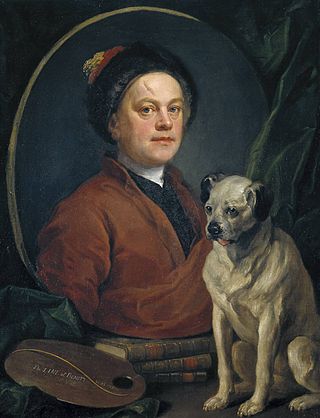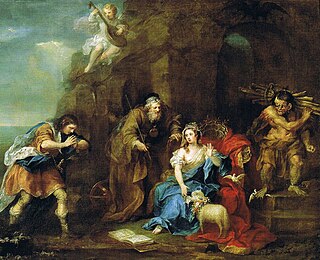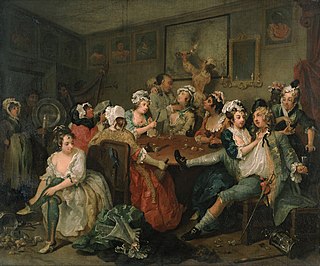
Hellfire Club was a term used to describe several exclusive clubs for high-society rakes established in Britain and Ireland in the 18th Century. The name most commonly refers to Francis Dashwood's Order of the Friars of St. Francis of Wycombe. Such clubs, rumour had it, served as the meeting places of "persons of quality" who wished to take part in what were socially perceived as immoral acts, and the members were often involved in politics. Neither the activities nor membership of the clubs are easy to ascertain. The clubs allegedly had distant ties to an elite society known only as "The Order of the Second Circle".

William Hogarth was an English painter, engraver, pictorial satirist, social critic, editorial cartoonist and occasional writer on art. His work ranges from realistic portraiture to comic strip-like series of pictures called "modern moral subjects", and he is perhaps best known for his series A Harlot's Progress, A Rake's Progress and Marriage A-la-Mode. Knowledge of his work is so pervasive that satirical political illustrations in this style are often referred to as "Hogarthian".

Sir Peter Courtney Quennell was an English biographer, literary historian, editor, essayist, poet, and critic. He wrote extensively on social history. In his Times obituary he was described as "the last genuine example of the English man of letters". Anthony Powell called him "The Last of the Mandarins".

Charles Churchill was an English poet and satirist.

Francis Dashwood, 11th Baron le Despencer, PC, FRS was an English politician and rake, Chancellor of the Exchequer (1762–1763) and founder of the Hellfire Club.

Hogarth's House is the former country home of the 18th-century English artist William Hogarth in Chiswick, adjacent to the A4. The House now belongs to the London Borough of Hounslow and is open to visitors as a historic house museum free of charge. Chiswick is now one of London's western suburbs, but in the 18th century it was a large village or small town quite separate from the metropolis, but within easy reach of it. Today the house is a Grade I listed building.
A Rake's Progress is a series of eight paintings by 18th-century English artist William Hogarth. The canvases were produced in 1732–1734, then engraved in 1734 and published in print form in 1735. The series shows the decline and fall of Tom Rakewell, the spendthrift son and heir of a rich merchant, who comes to London, wastes all his money on luxurious living, prostitution and gambling, and as a consequence is imprisoned in the Fleet Prison and ultimately Bethlem Hospital (Bedlam). The original paintings are in the collection of Sir John Soane's Museum in London, where they are normally on display for a short period each day.
A Harlot's Progress is a series of six paintings and engravings (1732) by the English artist William Hogarth. The series shows the story of a young woman, M. Hackabout, who arrives in London from the country and becomes a prostitute. The series was developed from the third image. After painting a prostitute in her boudoir in a garret on Drury Lane, Hogarth struck upon the idea of creating scenes from her earlier and later life. The title and allegory are reminiscent of John Bunyan's Pilgrim's Progress.
Events from the year 1764 in Great Britain.

Bedlam is a 1946 American horror film directed by Mark Robson and starring Boris Karloff, Anna Lee and Richard Fraser, and was the last in a series of stylish horror B films produced by Val Lewton for RKO Radio Pictures. The film was inspired by William Hogarth's 1732–1734 painting series A Rake's Progress, and Hogarth was given a writing credit.
Nationality words link to articles with information on the nation's poetry or literature.

Scene from Shakespeare's The Tempest, also known as Ferdinand courting Miranda is an oil painting by the English painter William Hogarth. It has been displayed at Nostell Priory since 1766, and was acquired by the National Trust in 2002. The National Trust claims that it is "the first known painting of a scene from Shakespeare".

Sigismunda mourning over the Heart of Guiscardo, fully titled Sigismunda mourning over the Heart of Guiscardo, her murder'd Husband, is an oil painting by British artist William Hogarth. Finished in 1759, it was the principal piece of the eight works he displayed in an exhibition in 1761. It was the final and most ambitious of his attempts to secure for himself a reputation as a history painter. It depicts a dramatic moment in one of the novelle in Boccaccio's Decameron. While Hogarth had expected this work to be acclaimed as a masterpiece of dramatic painting, the work was met with criticism and ridicule. In the catalogue of the exhibition of Hogarth's works at the Tate Gallery in 2007, the criticism was described as "some of the most damning critical opprobrium the artist ever suffered".

The Bad Taste of the Town is an early print by the British artist William Hogarth, first published in February 1723. The small print – 5 by 6 inches – mocks the contemporary fashion for foreign culture, including Palladian architecture, pantomimes based on the Italian commedia dell'arte, masquerades, and Italian opera. The work combines two printmaking techniques – etching and engraving – with etched lines made in the plate using acid and engraved lines marked using a burin.
Robert Hogarth Patterson (1821–1886) was a Scottish journalist and author.

Tavern Scene or The Orgy is a work by the English artist William Hogarth from 1735, the third picture from the series A Rake's Progress.
John Ranby (1743–1820) was an English pamphleteer, known for his anti-abolitionist writings. James Boswell interpolated in his Life of Johnson a reference to Ranby, his "learned and ingenious friend", as a pendant to Samuel Johnson's expressed wish for the abolition of slavery, stating that Johnson was poorly informed.

Trump was a pug owned by English painter William Hogarth. He included the dog in several works, including his 1745 self-portrait Painter and his Pug, held by the Tate Gallery. In the words of the Tate's display caption, "Hogarth's pug dog, Trump, serves as an emblem of the artist's own pugnacious character."

Jane Hogarth was a British printseller and businesswoman who preserved the rights to the artwork of her husband, William Hogarth, following his death. She successfully continued to produce and sell his work for many years.













